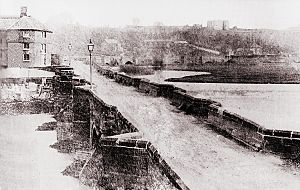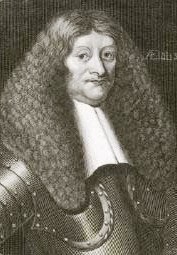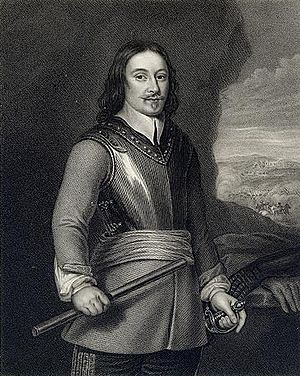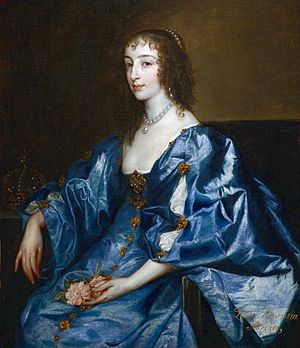Battle of Burton Bridge (1643) facts for kids
Quick facts for kids Battle of Burton Bridge |
|||||||
|---|---|---|---|---|---|---|---|
| Part of the First English Civil War | |||||||
 An early photograph of the medieval Burton Bridge looking from the town (Parliamentarian) side of the river |
|||||||
|
|||||||
| Belligerents | |||||||
| Commanders and leaders | |||||||
| Henrietta Maria Thomas Tyldesley |
Richard Houghton (POW) Thomas Sanders (POW) |
||||||
| Strength | |||||||
| 200 infantry 60 dragoons 1 cannon |
|||||||
The Battle of Burton Bridge was a fight during the First English Civil War. It happened on 4 July 1643, in Burton upon Trent. The battle was between the Royalists, who supported King Charles I, and the Parliamentarians, also known as Roundheads, who supported Parliament. At the time, Burton was held by Parliamentarian soldiers led by Captain Thomas Sanders and Colonel Richard Houghton.
The Royalists wanted to control Burton because of its important bridge over the River Trent. Queen Henrietta Maria needed to cross this bridge. She was traveling south from Yorkshire with important supplies for the King in Oxford. Royalist forces, led by Colonel Thomas Tyldesley, attacked the bridge. They charged across it and defeated the Parliamentarians. Many Parliamentarian officers, including Sanders and Houghton, were captured. After their victory, the Queen's convoy continued its journey. Colonel Tyldesley was made a knight and promoted for his success. Burton changed hands many times during the war. It finally came under Parliamentarian control in 1646.
Contents
Why Burton Was Important
The county of Staffordshire, where Burton is located, was quite far from London. People there often didn't like paying taxes to the King. For example, in the 1620s, they didn't raise any money for King James I's wars. Later, they also resisted King Charles I's "ship money" tax. This tax was collected even from inland areas, which was unusual.
In 1640, there were even riots in Uttoxeter. People were angry about having to send 300 men to fight in the King's wars against the Scots. Soldiers had to guard the new recruits to stop them from running away.
When the Civil War began in 1642, many people in Burton supported Parliament. This was partly because many Puritans lived there. Puritans disagreed with the Church of England's practices, which were supported by the King and Archbishop of Canterbury William Laud.
Burton in the Early War
Burton's bridge, a long medieval structure with 36 arches, was very important. It was called "the only passage over the Trent and Dove to the North." The bridge was located between Royalist towns like Lichfield, Tutbury, and Ashby-de-la-Zouch. It was also near Parliamentarian towns such as Stafford and Derby.
Even though it was important, Burton had no strong walls or natural defenses. Because of this, the town changed hands at least twelve times during the war. The Royalists first noticed it in late 1642. The Earl of Chesterfield used it as a meeting point for his soldiers. He later moved his forces to Lichfield for the winter.
There were old rumors that Burton had secret gunpowder for a Catholic rebellion. These rumors were found to be false. However, in 1643, a gunpowder store did explode. It destroyed the roof of St Modwen's Church.
East Staffordshire was strategically important because it was on the border between Royalist and Parliamentarian areas. Burton became important to the Parliamentarians in early 1643. Sir John Gell set up a Parliamentarian base in nearby Derby. In February, Gell placed soldiers in Burton. But he pulled them out less than a month later to help attack Newark.
Parliament's forces in Staffordshire were first led by Lord Brooke. After he died in March 1643, Gell took over. Gell's forces met with Sir William Brereton to plan an attack on Stafford. The Royalists found out about this plan. They sent cavalry led by the Earl of Northampton to stop them. Northampton's troops fought Gell at the Battle of Hopton Heath, where Northampton was killed.
Around this time, Queen Henrietta Maria landed in Yorkshire. She brought weapons from abroad for the King in Oxford. To clear the way for her, the King sent his nephew, Prince Rupert of the Rhine. Prince Rupert's troops captured Lichfield and placed Royalist soldiers in towns like Burton. However, Gell soon drove the Royalists out of Burton again. He placed his own Parliamentarian soldiers there. These included 200 foot soldiers, 60 dragoons (soldiers who rode horses but fought on foot), and one cannon.
The Battle
The Parliamentarian soldiers in Burton were led by Captain Thomas Sanders. Sanders had strong political views and was seen as a rival to Gell. He decided to put himself and his men under Colonel Richard Houghton, who was the military governor of Burton.
In July 1643, the Queen's convoy and its guards moved towards Burton. Gell tried to gather more Parliamentarian forces to defend the town, but they refused to join him. On 4 July 1643, the Royalist cavalry, led by Colonel Thomas Tyldesley, charged across Burton Bridge. They fought Sanders' men. The fighting was intense, and the town's St Modwen's church was damaged. The battle was decided at the bridge.
The Parliamentarian forces were soundly defeated. According to Gell, the town was severely damaged and looted. Queen Henrietta Maria herself wrote that her men took so much loot they had trouble marching with it.
The Royalists said they asked the town to surrender twice before attacking. They also claimed the Queen stopped any violence against the townspeople. However, the Parliamentarians said that 30 of their men were forced into the church. They offered to surrender but were refused and were killed by Royalist soldiers during the night.
The Royalists captured most of the Parliamentarian officers. These included Captain Sanders and Colonel Houghton (and his wife). Sanders was later exchanged for other prisoners. He was promoted and went on to raise a new group of horse soldiers. Tyldesley was knighted and promoted for his bravery in the battle.
What Happened Next
After losing Burton, Gell worried that Derby would be attacked. He brought troops from Nottingham and Leicester to defend it. He also got more supplies, including gunpowder and weapons. However, the Queen's forces did not attack Derby. They went around it and continued towards Oxford, as the King had instructed.
The new Royalist soldiers in Burton fortified the bridge. They controlled the town until Gell drove them out in January 1644. During this attack, Gell captured many Royalist officers and 500 men. Burton Bridge was again a key point in the attack. Gell claimed he lost no men in this fight. Gell then took his prisoners to Derby. Lord Loughborough soon retook Burton and the bridge for the Royalists. He wanted to use it to keep his forces connected.
Parliamentarian raids attacked Burton again in April 1644, but the Royalists soon regained control. Then, Sanders' new group of 400 horse soldiers retook the town. They almost captured Loughborough himself. Parliamentarian soldiers were placed in Burton in November 1644. But the Royalists drove them out by February 1645. King Charles I briefly made Burton his headquarters in May 1645. The town was finally taken by Parliament for good in early 1646. It became a supply center for forces attacking Tutbury and Lichfield.
After the war and the return of King Charles II in 1660, Burton remained a place where many people disagreed with the official Church of England. There were large Presbyterian and Baptist groups. This made some people in the Church of England question the town's loyalty.
Lasting Impact
The old medieval bridge where the battle was fought was replaced later by a Victorian-era bridge. On 2 July 1993, a plaque was placed on the bridge to remember the battle. It was put there by Sir Thomas Tyldesley's Regiment of the English Civil War Society.
Another monument remembers Tyldesley's bravery. It was put up in 1679 at the place where he died in a later battle. It mentions his "desperate storming of Burton-Upon-Trent over a bridge of 36 arches." For this, he was made a knight.
The Burton Bridge Brewery makes a beer called "Battle Brew" in honor of the battle. A local story says that Oliver Cromwell was near the battle and tied his horse to a nail at a church in Tatenhill, just 3 miles (4.8 km) from the bridge.
The medieval Burton bridge was also the site of an earlier battle in 1322. In that fight, King Edward II defeated the rebellious Earl of Lancaster.
Images for kids








